They found a link between the presence of the US military – quantified by the number and location of military bases in the Philippines – and potential conflicts within a certain geographical grid.
Four analytical models were developed to try to prove the hypothesis that “the possibility of politically violent conflicts in an area and its surrounding areas will increase if US military base(s) are present”.
Researchers also charted the frequency of political violence in the Philippines from 1989 to 2014 with changes in the number of US bases.
The authors did not respond to the Post for a request further explanation of the verification process.
The Philippines was selected for the study because of its long history of alliance with America and higher frequency of national conflicts compared with other Asia-Pacific countries.
“The presence of American military bases in the Philippines has led to an increase in political violence and conflicts in the local and surrounding areas,” the paper concluded.
However, an American international studies expert argued that the opposite was the case.
The research paper, published last month, said that after the collapse of the former Soviet Union, the purpose of US overseas deployments changed from containing the expansion of Soviet communism to combating terrorism. This encouraged more frequent communication between the US military and the host countries’ governments.

“It is presumed that these deployments were based on the American government’s discernment of its national interest at the time … and a shared interest with the host nations that accommodated its presence in their homeland,” he said.
“Whether one agrees or disagrees with the construction of these interests at the time of its formulation is a subjective matter.”
Tsinghua’s research team suggested that the reason US bases were more likely to lead to an increase in local conflicts was due to the “nullified deterrent effect of bases and negative public attitude in the host countries”.
However, the research methods in the study did not fully eliminate “endogeneity” concerns, even though the paper spotted this and added two more tests to explain the errors.
Endogeneity is a correlation between the explaining factors and other errors in the analysis that may lead to biases and make the model unreliable.
In particular, there could be outside factors not included in the research that played a role and led to inaccurate findings. This was noted by the authors of the paper.
The military-industrial complex is the top threat to peace. Can it be undone?
The military-industrial complex is the top threat to peace. Can it be undone?
Tellis said there were other factors that might influence domestic political conflicts, such as deep political divisions in the country, weak political institutions, or an ambiguous legitimacy of governing regimes.
“[For the last factor,] during the Cold War, this was rarely the case in Europe, but it was often the case in Asia,” Tellis said.
Harrison Pretat, deputy director and fellow with the Asia Maritime Transparency Initiative at US think tank Centre for Strategic and International Studies, said the picture was complex.
“It is hard to tell a single story of what impact US military presence has on a country because it has been involved in many different countries in different ways,” Pretat said.
“There is always a spectrum of views among politicians on how close the Philippines should align itself with the United States. But I’ve seen no indication that the country is anywhere near political violence because of it.”



